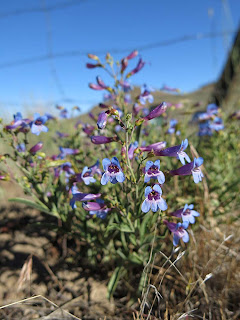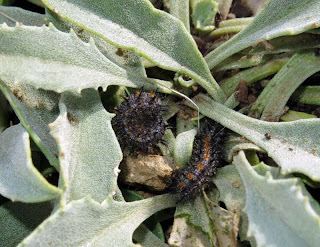I don’t get
to blog about Idaho very often. I was there briefly in 1998 just to rent a Jeep
to do some atlas blockbusting in Oregon, and then in September 2009 I was there
for the Western Field Ornithologists annual meeting.
Last weekend
I was in Boise for another meeting, this time the annual meeting of the
American Penstemon Society, held jointly with the Idaho Native Plant Society.
Attending was the great idea of my friend Jarid Simons who invited me. Neither
of us are particularly nuts about penstemons the way some people are (the Brits
and other Europeans have been hybridizing them for decades), but we both like
them a lot, and the field trips promised to be a botanizing bonanza.
The first
evening was a reception at the Idaho Botanical Garden a couple miles east of
downtown Boise. There we enjoyed the varied gardens next to the old
penitentiary, and I photographed this Agapostemon
metallic green bee in a four-o-clock.
The main
destination of our Saturday field trip was Leslie Gulch on the Oregon side of
the border, but our carpool first made a stop along Highway 95 still in Idaho in
a hilly area of sagebrush steppe where Penstemon
cusickii was the main target.
We were soon
in Oregon, turned off on a couple dirt roads, and our leaders Jean Findley and
Steven Love pulled over by a draw, opposite of which were some barren patches
of exposed, eroding dirt.
On these
bare patches one finds the rare and local Penstemon
miser, and we managed to find several plants, but only one had one flower
left.
I noticed a
few plants had some caterpillar damage, looked a little closer and noticed
these little caterpillars which I recognized as a checkerspot or some such
brushfoot but had no book. Later Jim Brock confirmed that they are Variable
Checkerspot, which is indeed known to eat Penstemon, but this species is
probably a new food plant record.
Another nice plant from here was this ray flowerless daisy Erigeron bloomeri.
We then
drove all the way down Leslie Gulch to where the road ends at the upper end of Owyhee
Reservoir – so low this year that it will be all the way down to the river bed
by the end of the summer.
Our main
stop was Dago Gulch, a side canyon of this geologically fascinating area. In
fact, it’s the unique geology – exposed ash flows of a very certain eruption
from Mount Mahogany – that probably explain the presence of so many localized
species of plants found only here and in other areas around Leslie Gulch.
Senecio ertterae, Ertter’s Groundsel is
one of these extremely local species found only here.
Another is Mentzelia pakardiae, Packard’s
Stickleaf.
I managed to
log 22 species of birds on our short hike here, including several
Black-throated Gray Warblers, lots of Lazuli Buntings (which almost everyone
who cared got to see), a few chasing White-throated Swifts, and a late migrant
“Western” Flycatcher.
Predictably
perhaps, I paid more attention to the bugs that anyone else did. This cooperative
Lorquin's Admiral was one among several that I saw.
Two-tailed
Swallowtail, our largest butterfly in the West, on the thistle Cirsium inamoenum.
These
cicadas, probably Okanagana bella, were
so abundant on all of the trees in the wash of Dago Gulch — some willows had
several dozen — I figured they must be related to the periodic cicadas of the
East (but they are not).
We had a few
more stops where our field trip leaders knew of some unusual plants that grown
on poor soils.
At this stop
we saw the very local and unusual Ivesia
rhypara. In the rose family and described in 1977, its name is a curious
Cockney-like play on words: “Rhypara” is Greek for “grimy,” which sounds like
Grimes; James Grimes was one of the first to discover the plant.
Our last
stop saw John Wise photographing a Penstemon
deustus growing right out of a boulder, earning its common name Hot Rocks
Penstemon.
–––
Sunday saw
us heading the same southwesterly direction from Boise, but staying on the
Idaho side of the border. We met on the Snake River with clouds of Cliff and
Bank Swallows flying over, then once all were present we moved on to an area
call Chalky Butte, as yesterday starting in the sagebrush steppe.
At this
elevation, our target, the early-blooming Penstemon
acuminatus was long past its prime, but there were plenty of other
interesting plants in this slightly saline soil. One of the coolest was this Astragalus kentrophyta var. jessiae, Spiny Milkvetch, looking more
like a spiny phlox rather than a pea.
But the best
find at this stop was this Western Rattlesnake, Crotalus oreganus.
The next
stop was on the way to the hidden Renynolds Creek valley. The bare soils at the
pass had a population of the local ball cactus Pediocactus simpsonii. I hadn’t seen this plant since my Oregon
bird atlassing on the northern ridges of Steens Mountain above Juniper Lake back
in 1998.
A Long-nosed
Leopard-Lizard was also fun find here.
Variegated
Meadowhawks were at nearly every stop this weekend, even far from water.
Our last
stop in the warm, dry lowlands featured this Tiger Whiptail (along with some
roadside Penstemon speciosus).
We then
spent the middle hours of the day a much higher elevation below War Eagle
Mountain on the road to the ghost town of Silver City. The mosaic of Douglas-fir,
Curlleaf Mountain-mahogany, and even patches of Subalpine Fir created a sky
island effect not too different from the mountains of SE Arizona. Common birds
here were Yellow-rumped Warbler, Cassin’s Finch, and House Wren – very
different from the sagebrush flats.
I didn’t
take very good notes, so I’m guessing here when I call this one Penstemon humilis.
And this one
Penstemon rydbergi. The plant list we
were given also had P. deustus, and
one of these might be that. Oops.
Some other
nice plants at this stop were:
Allium acuminatum
Eriogonum umbellatum
and Antennaria sp., Pussytoes
Bug-plant
interactions included these buprestid beetles, both Acmaeodera idahoensis, despite having different markings, on Hieracium cynoglossoides.
And this
gorgeous Juniper Hairstreak on Eriogonum
heracleoides.
Minus the
plant, we have this Machimus sp.
robber fly with some tiny thing in his jaws. I can’t even be certain which
order it is in, but I think perhaps Homoptera. [added note: Thanks to Andy Hamilton at Bugguide.net, the prey item is a Hemipteran (Homoptera doesn't exist any more), more precisely a leafhopper in the genus Ceratagallia. There are about 55 species in North America, and you need a better photo than this, or perhaps a specimen, to ID it to species]
Finally, we
made a stop at the highest elevation – New York Summit on the west side of War
Eagle Mountain, where the windswept Low Sagebrush flats didn’t look to
promising at first glance. But this Astragalus whitneyi ssp. circumvagum, Balloonpod Milkvetch was
quite fetching.
Even more
impressive was this patch of the stunningly gorgeous Lewisia rediviva, Bitter Root, an unusual member of the portulaca
family.
It was great fun to see some new areas, meet some really nice people, and be out in the field with "my kind of people" who stop and look at every plant and even know their names.






















































